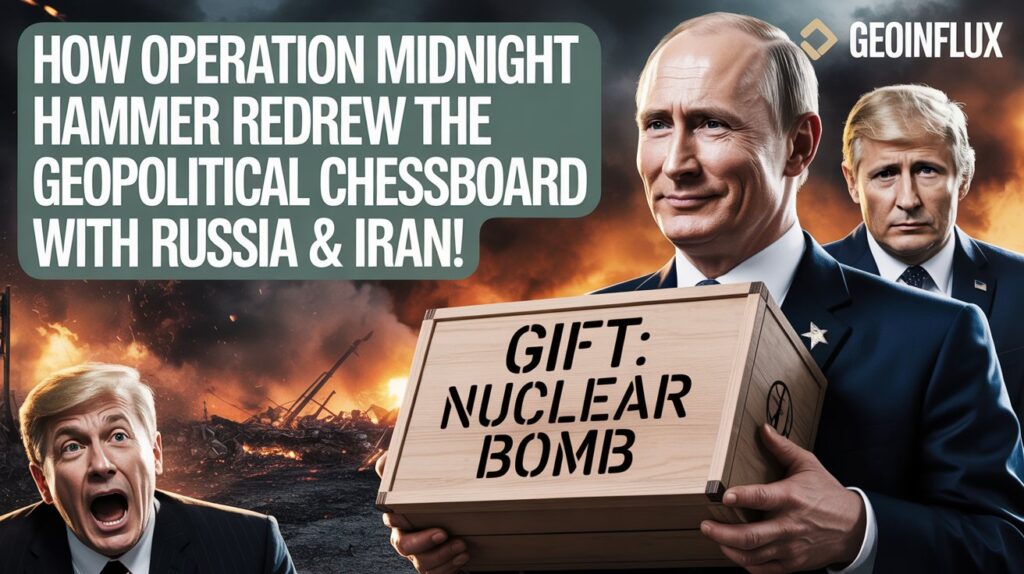Introduction: The Global Shockwave of Operation Midnight Hammer
A surprise US military action, codenamed Operation Midnight Hammer, has upended the geopolitical equilibrium in the Middle East.
This bold nocturnal assault on Iran’s nuclear infrastructure not only triggered an aggressive diplomatic backlash from Russia—Iran’s key ally—but also unleashed fears of nuclear proliferation, oil supply disruption, and prolonged conflict with Israel.
At the center of it all lies Operation Midnight Hammer: a strike that could redefine 21st-century warfare and alliances.
What Was Operation Midnight Hammer and Why It Matters
Operation Midnight Hammer was a high-stakes nighttime strike carried out by the United States against Iranian nuclear facilities. The operation involved long-range B-2 stealth bombers launched from the Atlantic, receiving aerial refueling near Israel before targeting key Iranian underground installations.
What made Operation Midnight Hammer especially impactful was its strategic deception: U.S. aircraft from Diego Garcia acted as decoys, while the real strike came from the West—bypassing Iran’s sophisticated air defenses.
Russia’s Reaction: Nuclear Resupply Threats Post Airstrike.
Russia’s response to Operation Midnight Hammer was swift and incendiary. Dmitry Medvedev, a former Russian President and close Putin ally, claimed that several countries were now prepared to supply Iran with nuclear warheads as retaliation for the U.S. action.
This marked a dangerous escalation. Medvedev’s rhetoric suggested that just as the U.S. aids Ukraine, Russia may now assist Iran militarily.
Possible Nuclear Warhead Sources:
- Belarus: Already hosting Russian nuclear warheads, could act as a direct supplier.
- North Korea: Known for its rogue nuclear program, could enter the equation.
- China: While not overtly involved, may discreetly assist under a “secret mission.”
This post-Operation Midnight Hammer realignment could break global nuclear non-proliferation norms and signal a new Cold War-like posture.
Iran-Israel War in the Wake of Operation Midnight Hammer
The fallout from Operation Midnight Hammer may ignite a full-scale war between Iran and Israel. Iran has reportedly braced for a six-month conflict, while Russia estimates the war may drag on for over a year, similar to its war in Ukraine.
War Cost Projections:
- Israel’s bombings cost nearly $1 billion/month
- A ten-month campaign could total $20 billion
- Most of this cost would be shouldered by U.S. taxpayers
These projections place Operation Midnight Hammer as a costly trigger for what may become a prolonged regional war.
Global Economic Risk: Strait of Hormuz After Operation Midnight Hammer
The strategic risk posed by Operation Midnight Hammer isn’t just military—it’s economic. The Strait of Hormuz, through which 20% of the world’s oil flows, could become a flashpoint.
Iran’s parliament has reportedly approved a motion to block the Strait, though the military has yet to act. U.S. Secretary of State Marco Rubio warned that doing so would be “economic suicide” for Iran.
Countries at Economic Risk if Strait Closes:
- China: Massive oil dependency from Gulf states
- India: Major importer of Iranian and Saudi oil
- Japan & Pakistan: Highly vulnerable to oil price surges
If Iran shuts the Strait in response to Operation Midnight Hammer, it may lose the very allies it hopes to gain—like India and China—who will pressure Tehran to reopen it swiftly.
Iran’s Nuclear Program: Damaged but Defiant Post-Operation Midnight Hammer
One of the central questions post-Operation Midnight Hammer is: Was Iran’s nuclear program truly dismantled?
Findings:
- Israeli PM Netanyahu confirmed Iran’s nuclear sites were “damaged” but not “eliminated.”
- The U.S. opted for bunker-buster bombs, not tactical nukes, to minimize fallout.
- Former President Donald Trump is believed to have rejected nuclear use to preserve U.S. global credibility.
Still, sources indicate that small nuclear tactical warheads remain “on the table” if bunker-busters prove insufficient. Operation Midnight Hammer may only be the first strike in a larger strategy.
The Future of Warfare: Lessons from Operation Midnight Hammer
Operation Midnight Hammer has showcased a modern template for high-tech warfare:
Key Tactics:
- Non-stop stealth bomber deployment
- Aerial refueling over allied airspace
- Decoy flights from Diego Garcia
- Precision strikes on hardened nuclear bunkers
These tactics represent the future of warfare—fast, unexpected, and geopolitically destabilizing. Every future military strategy must now consider Operation Midnight Hammer as a case study.
Conclusion: A New Era Triggered by Operation Midnight Hammer
Operation Midnight Hammer has set in motion a new era of global confrontation:
- Russia threatens to nuclearize Iran
- Iran prepares for a long war with Israel
- Oil markets face disruption via Strait of Hormuz tension
- U.S. military doctrine evolves to reflect new surprise-strike warfare
The next few weeks may unveil whether this was a one-time tactical strike or the first move in a geopolitical chess game with massive global implications.
🧾 Summary Recap Table
| Topic | Key Points |
|---|---|
| Operation Midnight Hammer | Surprise U.S. night strike on Iran’s nuclear facilities |
| Russia’s Response | Medvedev threatens nuclear warhead transfers to Iran |
| Iran-Israel War | Long, costly conflict expected — \$1B/month cost |
| Strait of Hormuz | Closure threatens 20% of global oil; China, India vulnerable |
| Nuclear Program | Damaged but still operational; nukes still a U.S. option |
| Military Strategy | Future wars may follow Midnight Hammer’s stealth blueprint |





